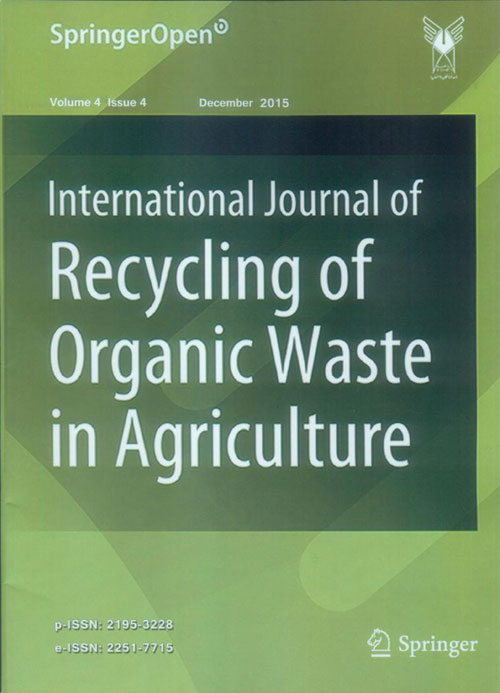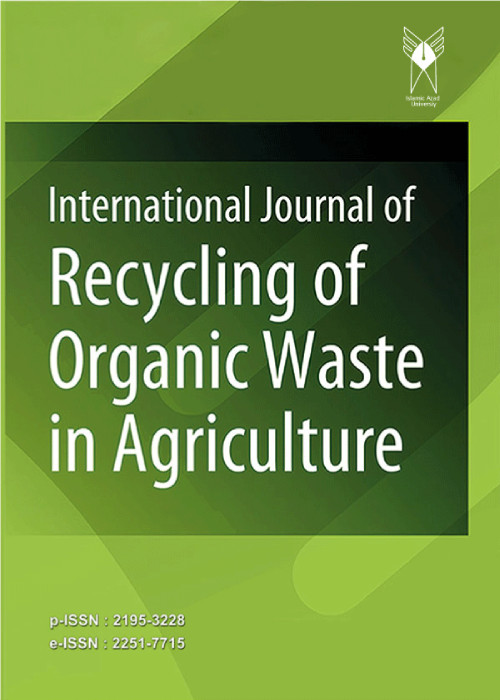فهرست مطالب

International Journal of Recycling of Organic Waste in Agriculture
Volume:4 Issue: 4, Autumn 2015
- 86 صفحه،
- تاریخ انتشار: 1395/02/01
- تعداد عناوین: 8
-
-
Page 233
Vermiwash contains enzymes, macro and micronutrients that could stimulate the growth and yield of crops. It can be prepared by different ways. In the present study, vermiwash was produced from the earthworm, Eisenia foetida, under field condition and also in the laboratory under cold and heat stress methods. These washes were used in different ratios for seed germination of mung, Vigna radiate. The results showed that the vermiwash produced by cold stress diluted at the ratio of 1:5 showed 100 % germination of mung seed followed by 1:5 ratio vermiwash produced naturally that resulted 95 % of seed germination. Undiluted vermiwash produced naturally and by cold stress showed 90 % of germination of mung seed than the undiluted vermiwash produced by heat stress. Cold stress produced vermiwash diluted with 1:5 ratio showed a vigour index of 1650 followed by naturally produced 1:5 ratio diluted vermiwash which showed a vigour index of 1092. However, the undiluted naturally produced vermiwash showed the lowest vigour index of 450.
Keywords: Vermiwash, Eisenia foetida, Cold stress, Heat stress, Germination, Vigour index, Seed, Vigna radiate -
Page 239Introduction
Organic carbon (OC) fractions play important roles in soil and many ecosystem processes. This study focuses on changing of OC in density and soluble fractions in a soil amended by nanozeolite and plant residues that incubated in lab condition for 90 days.
ResultsThe results showed that amounts of OC in light fraction (LF) and heavy fraction (HF) increased with the increasing percentage of nanozeolite and plant residues in the soil. The highest amounts of LF (7.54 g LF. kg-1 Soil) and HF (11.10 g kg-1 Soil) were found when 30 % nanozeolite and 5 % wheat and alfalfa straws were added to the soil. Accordingly, wheat and alfalfa straws were effective on increasing the LF and HF, respectively. However, they decreased with declining the OC from the 1st day of experiment until the 90th day of experiment. Soluble OC in hot (2.22 g kg-1 Soil) and cool (1.54 g kg-1 Soil) water fractions increased by addition of 30 % nanozeolite and 5 % plant residues particularly alfalfa straw in comparison with control. Although these soluble fractions increased after initial 30 days of incubation, they decreased in the continuation of the experiment.
ConclusionIn fact, OC contents in density and soluble fractions increased by addition of 30 % nanozeolite and 5 % plant residues into the soil; however, they decreased in initial 30 days of incubation with declining the OC. The findings of this research revealed the application of nanozeolite and plant residues improved carbon pools in density and soluble fractions and carbon sequestration increased by increasing OC contents in soil.
Keywords: Alfalfa straw, Wheat straw, Light fraction, Heavy fraction, Hot water, Cool water -
Page 249Background
Composting is one of the sustainable practices to convert sewage sludge into useful agricultural product because it is rich in organic matter, micro- and macronutrients, which is essential for plants growth and soil fauna to live. Therefore, the present study was to recycle the sewage sludge by rotary drum composter. Five sets of experiments (C/N 15, 20, 25, 30 including control) were carried out in the reactor, where sewage sludge was coupled with sawdust and cattle manure to attain the optimal feedstock. The process was monitored with respect to physico-chemical characteristics and stability parameters during 20 days of composting period. In addition, the kinetic parameters k m and r m have been evaluated in the present work.
ResultsHigher reductions in CO2 evolution and oxygen uptake rate (OUR) observed in C/N 30 showed the stability, resulting in the total biodegradable ingredients to be stabilized. Similarly, higher percentage reduction in carbon-nitrogen ratio was observed in C/N 30 followed by C/N 20, C/N 25, C/N 15 and control experiments, respectively, indicates maximum degradation was achieved; as it corroborate higher temperature regime occurred in C/N 30. The composting parameters such as moisture content, volatile solids, CO2 evolution, OUR and C/N ratio were reduced significantly (p
ConclusionsThe results suggested that composting of sewage sludge with optimal proportion of cattle manure and saw dust, especially in C/N 30, can produce stable compost within 20 days of composting.
Keywords: Sewage sludge, Sawdust, Rotary drum, C, N ratio, Stability, Kinetic analysis -
Page 261Background
Crop residues and agro-industrial by-products, available in appreciable quantities, can play a significant role in the nutrition of ruminants. The appropriate utilization of by-products in animal nutrition can improve the economy and the efficiency of agricultural, industrial and animal production. The present work investigates the bio-conversion of olive cake (OC), generated by the olive oil industries in Egypt, using locally isolated filamentous fungi in solid state fermentation, so as to upgrade its nutritional values and digestibility for its use as ruminants feed.
MethodsSeven non-mycotoxin producing fungal strains namely Trichoderma reesei F-418, T. harzianum F-416, T. virdie F-520, T. koningii F-322, Aspergillus oryzae FK-923, A. fumigatus F-993, and A. awamori F-524 were cultured on OC for 7 days at 36 °C. Subsequently, the chemical composition and lignocellulolytic enzyme activities of the resultant substrate were determined.
ResultsThe most promising result was obtained by A. oryzae FK-923, whereas, an increase in crude protein content ranging from 9.5 % (untreated) to 17.4 % (treated) was detected, while phenols were decreased from 3.1 to 0.92 % and fibers declined from 33 to 22.2 %. A reduction in the values of neutral detergent fiber (NDF) and acid detergent fiber (ADF) were reported. The addition of sugar cane molasses at 2 % showed an increase in crude protein to 18.9 % with a reduction in phenols and fibers to 0.69 and 21.8 %, respectively. Furthermore, the addition of active dry yeast (Saccharomyces cerevisiae) at 1.5 % to the fermentation medium raised the crude protein to 20.2 % (w/w), while phenols and fibers were declined to 0.55 and 19.2 %, respectively.
ConclusionsTherefore, the present findings revealed A. oryzae FK-923 to be an efficient organism for lignocellulolytic enzymes production and simultaneous enhancement in crude protein and in vitro digestibility of OC.
Keywords: Olive cake, Biological treatment, Solid state fermentation, Ruminants feed -
Page 273Introduction
The use of by-products such as swine manure (SM), poultry waste (PW), urea (U), molasses (M) and bakery by-product (BB) is an alternative method for lamb feeding. The objective of the present study was to determine the chemical composition, dry matter intake and digestibility in growing lambs using ensiled PW combined with BB (PWBB), SM with BB (SMBB), SM with M (SMM) and U with M (UM) in their diets.
MethodsFour silagesPWBB, SMBB, SMM and UMwere prepared, the chemical composition of the silages was determined (n = 3), silages and concentrate ratio (60:40) as fresh matter were given to growing lambs over 21 days as total period, and the collection of samples to determine intake and digestibility was carried out for the last 7 days, in a 4 × 4 Latin square design, with a significance level P
ResultsThe organic matter (OM) was lower (P
ConclusionsThe use of PWBB, SM combined with BB or M is an alternative method for lamb feeding, provided that a proper formulation supplies the nutrient requirements of crude protein and diminish the N excretion compared with UM diet.
Keywords: Poultry waste, Fresh pig manure, Bakery by, product, Silage, Lambs -
Page 279Purpose
Traditional organic formulations are widely used as a plant growth promoters; however, the knowledge on the microbial aspect of traditional organic formulations is still limited. The aim of this study was to illustrate the cultivable bacterial diversity of various traditional organic formulations and their potential for early plant growth promotion.
MethodsFive different traditional organic formulations such as 100 % panchagavya, 33 % panchagavya, plant extract with native microorganisms, commercial organic fertilizer extract with two percent leaf soil extract and commercial organic fertilizer extract with 2 % yogurt were prepared and used in this study. The liquid fraction of these traditional organic formulations were used to analyze the beneficial effect on plant growth by seed treatment and foliar applications.
ResultsBacterial 16SrDNA analysis revealed that the isolates fell into forty-three different genera, which can be grouped into seven different classes, such as Alphaproteobacteria, Actinobacteria, Bacilli (or Firmibacteria), Betaproteobacteria, Cytophagia, Flavobacteriia and Gammaproteobacteria. Higher bacterial diversity was observed in cow dung followed by 33 and 100 % panchagavya. Radish and Chinese cabbage seed germination and growth were significantly improved by traditional organic formulations compared to control.
ConclusionThe results of this study showed that the bacterial diversity changes depend on the type and concentration of ingredients used in traditional organic formulations. Substantial increase in plant growth by the traditional organic formulations indicates the suitability of using these organic preparations in eco-friendly agriculture.
Keywords: Eubacterial diversity, Organic farming, Organic formulations, Panchagavya, Plant growth, promoting bacteria -
Page 291Purpose
Field experiment was carried out in Akure in the rainforest zone of Nigeria to determine the effect of poultry manure, wood ash and rice bran on the soil fertility improvement, growth and head yield of cabbage (Brassica oleraceae L) in 2011 and 2012 cropping seasons.
MethodsThe three organic fertilizer treatments were applied each at 6 t/ha with a reference treatment NPK 15-15-15 applied at 300 kg/ha and a control treatment arranged in a randomized complete block design with three replicates.
ResultsThe results showed significant increases (P
ConclusionThe poultry manure applied at 6 t/ha gave the best results in improving soil fertility, growth and head yield of cabbage, and this was because of its balanced nutrient composition and the least C/N ratio.
Keywords: Cabbage (Brassica oleraceae), Head yield, growth parameters, Organic fertilizers, soil fertility improvement -
Influence of vermi-fortification on chickpea (Cicer arietinum L.) growth and photosynthetic pigmentsPage 299PurposeThe aim of this study was to investigate the effect of different vermicomposts and their dosages on chickpea (Cicer arietinum L.) plants in pot culture experiment.MethodsA total of five potting media were prepared containing soil and vermicompost. Soil fortified with 10 and 20 % vermicompost was used as potting media. The fertility status of soil and vermicomposts was quantified. In these potting media, growth, yield and biochemical parameters of chickpea plants were studied up to 90 days.ResultsThe results showed that the fortification of soil with vermicompost significantly stimulated the chickpea plant growth. The plant height, plant shoot biomass, number of pods and photosynthetic pigments were significantly higher in vermicompost-fortified experiments, whereas vermicompost fortification had no significant effect on chickpea seed germination as it was ≈100 % in all experiments. Total chlorophyll content in chickpea leaves was in the range of 0.4371.07 mg/g. Similarly, carotenoid content was minimum in control and maximum in 20 % vermicompost containing potting media.ConclusionIt was concluded that if soil is fortified with appropriate quantities of vermicompost, the chickpea production per unit area could be enhanced significantly.Keywords: Chickpea, Organic manures, Vermicompost, Chlorophyll, Carotenoids, Vermi, fortification


